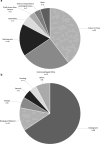Intussusception around jejunal feeding tubes in pediatric patients: a retrospective two-center experience and management strategies
- PMID: 41037207
- PMCID: PMC12491077
- DOI: 10.1007/s00383-025-06209-1
Intussusception around jejunal feeding tubes in pediatric patients: a retrospective two-center experience and management strategies
Abstract
Introduction: Jejunal feeding via endoscopic, fluoroscopic, or surgical tube placement is widely used in pediatrics. A rare complication is intussusception around the jejunal feeding tube (JFT), which can cause obstruction or bowel ischemia. This study evaluated risk factors and management strategies.
Methods: We retrospectively reviewed all children undergoing JFT placement or revision at two centers (2014-2025). Patient and procedural data were analyzed.
Results: Among 58 patients (163 procedures), 7 children (12%) developed 8 episodes of intussusception. Median age at placement was 1 year (IQR 5); intussusception occurred a median of 1.16 years later (IQR 4.38). Five episodes resolved spontaneously, 2 by hydrostatic reduction, and 1 during unrelated surgery. Neurological impairment was present in 62% of patients. Kaplan-Meier analysis showed the highest risk within 1-2 years post-placement. Events occurred after endoscopic (6/43), surgical (1/13), and fluoroscopic (1/2) placements, with no clear link to technique.
Conclusion: Intussusception around a JFT is rare but clinically significant. It should be suspected in children with abdominal pain, bilious vomiting, or feeding intolerance. Most cases can be managed non-surgically; our algorithm supports ultrasound diagnosis, observation or hydrostatic reduction, and surgery only for ischemia or failed conservative treatment.
Keywords: Complication; Feeding tube; Intussusception; Jejunal feeding.
© 2025. The Author(s).
Conflict of interest statement
Declarations. Conflict of interest: The authors declare no competing interests.
Figures



References
-
- Mccann C, Cullis PS, Mccabe AJ, Munro FD (2018) Major complications of jejunal feeding in children. J Pediatr Surg 54:258–262. 10.1016/j.jpedsurg.2018.10.078 - PubMed
-
- Fortunato JE, Darbari A, Mitchell SE et al (2005) The limitations of gastro-jejunal (G-J) feeding tubes in children: a 9-year pediatric hospital database analysis. Am J Gastroenterol 100:186–189. 10.1111/j.1572-0241.2005.40893.x - PubMed
-
- Nicholson FB, Korman MG, Richardson MA (2000) Percutaneous endoscopic gastrostomy: a review of indications, complications and outcome. J Gastroenterol Hepatol 15:21–25. 10.1046/j.1440-1746.2000.02004.x - PubMed
-
- Broekaert IJ, Falconer J, Bronsky J et al (2019) The use of jejunal tube feeding in children: a position paper by the gastroenterology and nutrition committees of the European society for paediatric gastroenterology, hepatology, and nutrition 2019. J Pediatr Gastroenterol Nutr 69:239–258. 10.1097/MPG.0000000000002379 - PubMed
-
- Williams A, Borsellino A, Sugarman I, Crabbe D (2007) Roux-en-Y feeding jejunostomy in infants and children. Eur J Pediatr Surg 17:29–33. 10.1055/s-2007-964929 - PubMed
Publication types
MeSH terms
LinkOut - more resources
Full Text Sources

